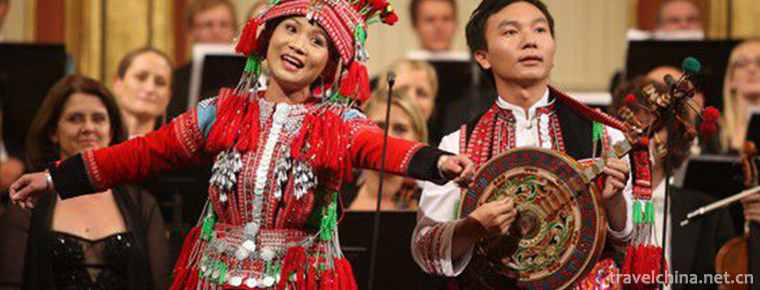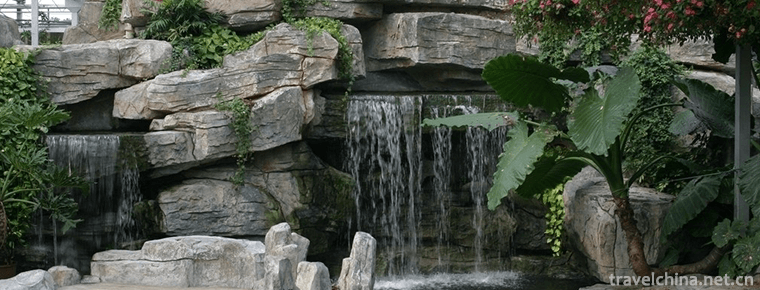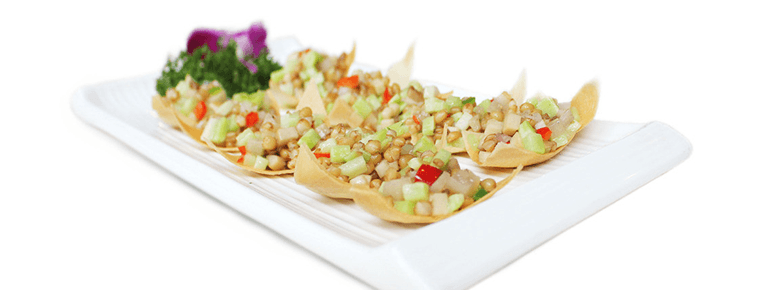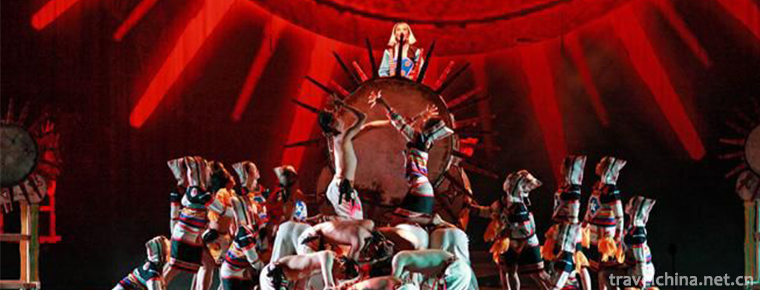The seafood tune of the Yi nationality
The seafood tune of the Yi nationality
Shiping Yi seafood tune, also known as "Shiping tune" and "Quzi", is commonly known as "inverted paddle". It is named after a herbaceous aquatic plant called "seafood" in Yilong Lake. It is popular in Nisupo (Sandaohong) inhabited areas such as Yilong Lake, Yaziba, Niu Street and Sixth Street of Longpeng. At the same time, it is also loved by the Han people and spread in Jianshui, Kaiyuan, Tonghai, Gejiu and other places. Haicaiqiang is created by the Yi working people in their long-term work and life, and it is derived from the folk songs sung by young men and women in the mountains, fields and lakes.
On May 20, 2006, the Yis'seafood accent was approved by the State Council and listed in the first batch of national intangible cultural heritage list.
Brief introduction
The Yi people, known for their ability to sing and dance, are permeated with folk songs in all aspects of their lives. They are an important form of expressing their feelings, self-education and entertainment. Folk songs are used to record history, exchange emotions, impart culture and master agricultural seasons. Whether in sacrifices, festivals, weddings and funerals, or in labor and production, love, renovation and other activities, we can hear cheerful, simple, euphemistic and full of strong local flavor of singing.
The original meaning of seafood tune is the tune sung on the "sea", which is named after an aquatic herb named "seafood" in the local Yilong Lake. It was created by the Yi people in their long-term work and life, and evolved from the folk songs sung by young men and women in the mountains, fields and lakes. It has a long history. Since its birth, it has been widely spread in rural and urban areas with Yilong Lake as the center.
Haicai Tune of Yi Nationality is a well-known folk song variety of Yi Nationality in Yunnan Province at home and abroad. It is also called Dapan paddle and inverted paddle, commonly known as Shiping Tune. It mainly spreads in the Nisu village of Yi Nationality in Shiping County, Honghe Hani Autonomous Prefecture, Yunnan Province. Shiping Yi seafood tune belongs to the folk song of seafood tune variant. It is called "four tunes" together with other three variants of Shayou tune, four tunes and Wushan tune, and is called "tune" by the Yi people.
historical origin
origin
Haicai Tune, commonly known as Shiping Tune, is the first of the four tunes in South Yunnan. It originated from the original ecological folk songs near Yilong Lake in Shiping County. The scenery of Yilong Lake is beautiful, and there is a kind of aquatic herb growing in the lake. It is called seaweed. Its long rhizome is green, and its head is full of small white flowers. It emits a light fragrance and can be eaten. Legend has it that the ancestors of the Yi nationality swung oars to fish in the Yilong Lake or
Picking seafood, fishermen singing while rowing, over time formed a beautiful seafood tune. However, when Mr. Wang Zhimin mentioned the seafood tune in the article "Research on Red River Folk Music and Dance", there are two representative statements:
One is Mr. Bai Zhangfu's famous theory. In his article "A Preliminary Study on the Origin and Development of Yi Seafood Cafe", he said: Shiping "Sweet pomegranate in Dashuicun area is well-known in southern Yunnan, and seafood cafe is also known as pomegranate flower, which is named for it."
Second, the seafood accent originated from the Yi language. According to Mr. Xu Xiangkun's article Shiping Yi Nationality and Haicai Tune, the name of Haicai Tune first appeared in the artistic literature of Shiping County Chronicle. Among them are Shiping Lingong Hu Ying's "fragrant rice flowers, fragrant Yulu thick, Yueming fishing words full bow. Xiao Man's paddling power is Monri, and the seafood cavity is sharp and wakes up the sleeping gull. The Seven Quintessential Poems. This is the record of seafood accent in words. But Mr. Xu believes that it is not the beginning of the naming of seafood accent that literati and poets have included it in their poems and essays. Therefore, from the perspective of Yi language, he analyzed it and thought that "reading seafood in Chinese can be read as Haiji". The sea pronunciation of `black'in Yi language is similar to that of `sea' in Chinese. The Yi dialect's "song pairing" is "Ji". To say "Heiji" in the Yi dialect means "song pairing on the sea". However, the Han people hear that "Heiji" comes from "seafood". So when I saw Yi men and women rowing boats and singing to each other at sea, I said I was going to sing "Sea Vegetable Tune"... In fact, we should first have "Heiji" and then "seafood". "By hunting and fishing, this may be the basis for seafood cavity to be produced at sea."
Although the above two statements have their own grounds, there is another one: "The local Yi people think that the seafood tune originated from the Bank of Yilong Lake. It is said that in the late Yuan Dynasty, there was a war on the Bank of Yilong Lake. The two sides fought for seven days and seven nights before the end of the war." The victorious party burned campfires and set up banquets to celebrate the victory in the Five-turn Store (on the island of Rose Temple) near Yilong Lake. In singing and dancing, the common people arranged the dialects of the Yi dialect into regular lyrics and sang them out, and then spread in the Yi villages near the lake. In the later evolution, some people sorted out its rules and formed the seafood tune. The reason for the name of seafood tune is that the Yi people on the Bank of Yilong Lake like singing and dancing very much. They also need to sing when fishing and talking about seafood in the lake. The tone of the song is very long and charming. In the process of singing, people feel as long as picking seafood. As the name implies, it is called seafood tune.
In fact, no matter what kind of statement, it is inseparable from the specific environment and people's production and living habits and the specific environment in line with the mentality. That is to say, the origin of any name can not be separated from a deep social foundation. It can be seen that Haicaiqiang is not only a true portrayal of the historical life of the Yi people on the banks of Yilong Lake, but also a concentration of the ideological, emotional and ideal pursuit of the ancestors of the people living in Shiping County.
Formation
The formation of seafood tune of Shiping Yi nationality originated from the activity of "eating tobacco". The custom of "eating tobacco and tobacco" is a unique way of love for young Yi people. On the rare night of moon stars, a young man in one village usually chooses a playground first, then brings a smoke pipe, four strings and food to invite young women in another village to participate. Young men and women gathered in the selected venues outside the village, lit bonfires, played with cigarettes and sang, danced and played happily. Men and women are strict in singing songs and speaking vernacular. They have to be correct in words and correct in answers. If a woman loses, she must light a cigarette for him. If a man loses, he will be looked down upon and left out. Among them, the lead singer sings real words in real voice and falsetto function words in order to make them more lyric, and make the music climax alternate, pleasant and pleasant, so as to gain aesthetic feeling. In the course of singing, between the lead singer and the accompanist, they either murmur and sing, or indulge in singing, endless songs, all night long. Many young people express their feelings here, and finally form a marriage.
Of course, singers improvise in order to express their feelings when they are working, in the mountains and lakes. Since ancient times, there has been the saying that "hungry people sing their food and laborers sing their things". Seafood tune singing, out of heart, stimulates the true feelings. Sometimes standing at the bow of the boat, "pull" a tune, can sing fish out of water; sometimes standing at the top of the hill, "drink" a song, birds will fly out of the forest. Therefore, the Yi seafood tunes are all singers who can't help blurting out when touching the scenery. They are always exporting into chapters, which fully demonstrates the talent and wisdom of the people. For example, when I interviewed Xiaotala Village, the local singer wrote his own story.
Singing: "As soon as you enter the park, all the guests come to sing, singing about the great changes in Shiping, the people of the county rush to a well-off society." This delicate technique of expression also forms the singing style of the Yi people. The Yi people believe that the beauty of a person is not in his appearance. Only when he can sing and dance well and sing well can he have the most aesthetic feeling. Therefore, the articulate, fluent answers, skilled four-string performers, although not beautiful figure, outstanding appearance, but much favored and loved the curtain, known as "music master" and "four-string boss".
It can be seen that singing is the self-expression of the people's voice. The folk songs of any nation are a mirror of the nation's social history, times life and national customs.
Development
Yi folk songs originated from labor and spread among the people. For thousands of years, it has been continuing and developing. It varies from place to place and has strong regional characteristics. With its beautiful melody and catchy lyrics, i.e. sexual expression, seafood tune is popular among the Yi people and is the flower of national art cultivated by the Yi people.
From an early age, men and women in the Yi family listen to adults'songs, hear, witness, understand, and all things become poems by mouth. They are hatred, love, voice and express their feelings directly. Whether in lakes, mountains or fields, songs can be sung to each other at any time. Men and women sing to each other, and their feelings are melodious and happy, but they do not want to stop.
Yuan Run, a Shiping man in the Ming Dynasty, once served in the army and lived in seclusion. He often went to the mountains to play. He listened to the woodcutter singing seafood tunes and wrote down the Five Rules "Fishing Songs of the Rite Society":
Ritual club fishermen's music, wind and Qing evening boating.
Singing pity and tongue skillful, love water in autumn and autumn.
G is ripple and broken, light bowel moonlight floating.
Fish soup is always full, not like worrying people.
Hu Ying, a scholar in Shiping in the early Qing Dynasty, took advantage of the moon to visit Yilong Lake and immediately chanted, "Fragrant rice flowers are light, jade and dew are thick, and fishing words are full of the bow of the boat at the moonlight." Xiao Man paddles and wakes up sleeping gulls in seafood chamber.
During the Republic of China, Yi women in Shiping carried things from the west to Simao and Puer, singing seafood tunes, dancing cigarette boxes and combining work and leisure to relieve their fatigue. In the 40 volumes of Yizhi of Shiping County Records of the Republic of China, "Yiren women go to Simaodi to carry tea to Pu'er for others". Every time they sing "Xu Huo" tune for fun, also known as "Xu Huo" (press: cigarette box dancing folk also known as "Xu Huo").
The records of seafood tune in these historical materials show that seafood tune has a long history and is the traditional art form of singing and dancing of the Yi people. During its formation and development, it was deeply influenced by Han culture brought about by Han immigrants in Ming and Qing Dynasties. Since the Qing Dynasty, there are many records and poems about seafood tune singing in local chronicles. A complete seafood tune is usually composed of restrained tune, empty tune, Zhengqi tune and vernacular tune. It is a large vocal suite with complex structure and large length. It is composed of many parts, including solo, duet, lead, chorus and so on. The representative repertoires of seafood tune include Brother Singing Little Songs and Girls Coming to Learn, Shiping Olive Vegetables and so on.
Current Situation of Development
Due to the tourism development in recent years and the vigorous publicity of CCTV's "Qingge Competition", many foreign tourists have come to Yilong Lake in Shiping to enjoy the "seafood tune". Because of the convenient transportation, the life style of the local people in the vicinity of Yilonghu Lake gradually tends to be urbanized. With the improvement of living standards, the original production and living customs of the local people are also quietly transforming. The Nisu people who used to wear ethnic costumes have been completely Han-style. Minor tune.
There are very few Yi people fishing in Yilong Lake. On the contrary, there are many "food boats" in the lake in recent years. According to statistics, there are about fifty such restaurant-style "food boats" in the whole Yilong Lake. They use fresh fish caught in Yilong Lake and seafood produced in the lake as the main food source to attract tourists to do business. During the meal, if someone asks about "seafood chamber", the boat owner. Nisu girls and young men in beautiful "Huayao" costumes will be lined up at the bow of the boat and sing a melodious and beautiful Yi minor in southern Yunnan. Diners will enjoy the song while tasting the delicious food, which has become one of the characteristics of the tourism of Yilong Lake.
External performance
In 2007, Yis seafood tune appeared at UNESCO headquarters.
In 2009, the Yis seafood tune performed at Zhongshan Hall in Taipei.
artistic characteristics
Singing Form
The singing form of seafood tune is unique, and it is known as the "bel canto" singing method in the nation. It belongs to a kind of folk song in the form of pair singing, with lead singing and help tune.
Ask and answer. Broad range, vigorous and agitated, beautiful and beautiful, melodic fluctuations coherent, euphemistic and melodious, like the water of Yilong Lake, clear and bright, sound waves like waves.
From childhood, men and women at home listen to adults'songs, hear and witness, and understand with heart. Everything becomes a poem by mouth, which means hate is love and expresses feelings directly. Whether in lakes, mountains or fields, songs can be sung to each other at any time. Men and women sing to each other, and their feelings are melodious and happy, but they do not want to stop.
Originally a folk song minor, Haicai tune has developed into dozens of "tunes". The singing form of "seafood tune" is unique. At the beginning of singing, men and women
Both sides want a paragraph of Chinese, which is an opportunity for both sides to fully display their knowledge, ability and artistic level in the process of mutual promotion. It is an indispensable process of mutual understanding in the process of love. Its basic form of singing is mainly composed of singing by one person and singing by many people. There are also men and women singing in pairs. The main tune of seafood tune is a seven-word absolute sentence. The content of the song generally plays the role of expressing ideas and wishes.
The lyrics of "Haicai Tune" of the Yi nationality are Chinese. The tunes keep the Yi music style, rhythm meticulous and changeable, and the melody is long. The accompaniment of musical instruments is mainly composed of four strings, sometimes accompanied by leaf blowing. However, it is generally not accompanied by instrumental music. When you open your mouth, you will have a round tune, probably because of the practice in labor and walking. "Sea Vegetable Tune" is mainly composed of duet singing, dubbed vernacular in the song, produced into chapters, eloquent, interesting, not new.
The lyrics of "Haicai Tune" can be categorized into three parts: trial, deliberation, pull, hot song, sweeping song, divorce song, hanging song, complaint song, leisure song, weird song and so on. They are all improvised works with emotions, reflecting the joys, sorrows and joys of young men and women in love life.
representative figure
Haicai tune is a favorite singing form of the Yi people and has entered the world intangible cultural heritage protection catalogue. Li Huaixiu and Li Huaifu's elder sister and younger brother made the world know the Yi culture by singing, which is worthy of the title of "Yunnan Song King".
On the evening of August 9, 2006, when Li Huaixiu and Li Huaifu took the first prize of the original ecological singing method in the 12th CCTV National Youth Singer Television Grand Prix from the awardees, the hearts of the Yi elder sisters and brothers from Shiping, Yunnan, soared like the auspicious birds in their entry song "Auspicious Birds Fly Up".
"Haicaiqiang" originated in the Yi people's living area of Shiping County, Yunnan Province, where farmers often sing this kind of soft and long folk songs in the field, which undoubtedly provides a unique environment for the music growth of Li Huaixiu and Li Huaifu's sister and brother who lived here since childhood.
Sister Li Huaixiu has been learning "seafood tune" with local folk artists since she was 12 years old. After entering Yunnan Ethnic Cultural Heritage Museum, Li Huaixiu has successively learned from famous folk singers such as Baoyun, Shi Wanheng and Ajiawen, which has not only improved his singing skills, but also mastered the singing methods of Yam Opera, Four Opera Opera and Wushan Opera. In addition, Li Huaixiu also studied Shiping Yi folk cigarette box dance, Huayao Yi branch dozens of sets of songs and dances, as well as some of the Hani, Naxi, Wa, Nu, Tibetan and other ethnic groups. With excellent singing and dancing skills, Li Huaixiu has participated in many performances and competitions at home and abroad and won more than 10 awards.
My brother Li Huaifu is the fourth in the family. He has been diligent and eager to learn since childhood. He likes singing, dancing and national musical instruments. In 2000, he also successfully entered his sister's "Yunnan National Cultural Heritage Museum". Li Huaifu learned not only the cigarette box dance and the four tunes of southern Yunnan, headed by the "seafood tune", but also the Honghe song and dance with Li Wenyi. With the help of teachers and sisters, Li Huaifu's singing and dancing skills are getting better and better. In the past few years, he has exchanged and studied with experts and scholars at home and abroad many times and performed with them on the same stage.
In January 2004, together with her teacher Shi Wanheng, Li Huaixiu won the gold medal of the native chorus in the Western Folk Song Contest held by CCTV. In August of the same year, Li Huaixiu and Li Huaifu joined in the second Northwest China Folk Song Racing Competition held in Zuoquan County, Shanxi Province, and won the laurel of "King of Chinese Folk Songs" at one stroke. Next is to attend large-scale literary and artistic performances throughout the country one after another... Since 2004, audiences all over the country have begun to recognize this pair of sisters and brothers from Shiping County, Honghe Prefecture, Yunnan Province, and have begun to recognize the "seafood tune".
However, people really began to notice that the original national singing method of "seafood tune" was at the 11th Youth Singer TV Grand Prix in 2004. At that time, Li Huaixiu and Li Huaifu's sister and brother conquered judges and audiences with an original and authentic "Seafood Tune", which also triggered a debate in Chinese music circles. A stone stirred up a thousand waves. Besides its artistic charm, this folk song from the original ecology of Ailao Mountain also brought the performance and expression of folk art to the forefront of the wind for the first time. While touching the audience with the song, it broke the traditional criteria of judgment in the music circle and aroused controversy among experts and judges.
Because their singing broke the traditional evaluation criteria of the music industry, they failed to reach the finals. This caused a great discussion in the vocal music circle of the whole country at that time, and provided an important reference for the development of national music. For this reason, the original singing group was set up in the 2006 Youth Singer TV Grand Prix.
The two brothers and sisters won the golden prize of the original ecological singing method in the 12th Green Song Competition, which not only reminded the audience of the two brothers and sisters of the Yi nationality, but also remembered the "seafood tune". Some audiences said that we were like the trees, flowers and plants around them, listening to them singing freely on the mountain, the song was natural and clear, free and cheerful. Some audiences say that their songs have traversed the time and space of history, enabling us to appreciate a kind of unfamiliar national customs, so that people in the city feel a long-lost fresh wind.
Inheritance Significance
The Meaning of Art Form
As a traditional art form produced in a specific environment, Haicai Opera has a high degree of adaptability and extensive popularity in a specific ecological, social and cultural environment. It is of great value in the study of the development history, cultural history, moral values, artistic thinking mode and the blending of Yi and Han cultures. To systematically explore, rescue and study the folk songs of minority nationalities represented by seafood tune is also of positive significance for enriching and perfecting the study of Chinese traditional music system and music history.
With the disappearance of the communicative custom of "eating tobacco" and the introduction of other forms of cultural entertainment, which depend on the seafood tune since 1950s, the singing of seafood tune has gradually declined. Nowadays, there are few "song master" and "song owner" who can sing a complete set of seafood tune (both honorific names for famous singers) in their younger life. There are few hobbyists of seafood tune in China, whose inheritance is facing a serious crisis and needs to be protected urgently.
The state attaches great importance to the protection of intangible cultural heritage. On May 20, 2006, the Yi seafood tune was approved by the State Council and listed in the first batch of national intangible cultural heritage list.
Significance of Cultural Impact
Culture is one of the foundations of the existence and development of a nation and a country. Strengthening the comprehensive national strength calls for the prosperity and development of culture. Therefore, building a harmonious culture is the spiritual guarantee of building a harmonious society. Because of its entertainment and strong mass participation, singers have made several trips to Beijing and Huairen Hall in the Central South China Sea to perform for the central leaders. Their high and euphemistic tunes have won unanimous praise from experts at home and abroad.
To carry forward the cause of national culture, we need to have a cultural perspective. The highest value of culture is not identity, but its uniqueness. In the Yunnan Imagery by Yang Liping, a famous Chinese dancer, and the large-scale sound poetry and painting Huayao Fangge, the seafood tune occupies a certain proportion. Haicai Tune came out of the mountains and Yunnan Province, and was called the "sounds of heaven" when performing abroad. Nowadays, there are fewer and fewer people who know how to sing seafood tune. If you want to appreciate the charm of seafood tune, you can go to see "Yunnan Image" and perform at Yunnan Art Theater at 20:00 every night. The seafood tune of the Yi people in Yunnan Images is drawn from the Huayao Yi people in Shiping County, Yunnan Province. The performers are all from villages. The singing and dancing are very authentic. The people of Yunnan sing their hometown with their sweet songs, and at the same time they are proving to the world that Yunnan is a paradise of songs and one of the treasures of our national music. Therefore, in the increasingly globalized ecological environment of today's world, it is in the way of insisting on the uniqueness of culture that people adhere to their national spirit to undertake the historical mission of cultural inheritance.
Mr. Lu Xun once said, "Only the national is the world." In order to let the world know the national culture of the Red River, the people of the Red River have been devoting themselves to the excavation and development of the national culture. As a "bel canto" singing method in the national culture, the seafood tune is not only the absolute singing of the Yi family, but also the inheritance of the original ecological singing and dancing. Nowadays, there are seafood singing groups in Yilong Town, Longpeng Town and other rural cultural stations in Yilong Lake, Shiping County. Every year, there is also a national folk "seafood cavity cigarette box dance" competition, which greatly improves the protection of seafood cavity, a intangible cultural heritage. People have realized the precious value of their own national culture, so the protection and promotion of inheritance has become the first task.
"Five-step and three-step scholar, to the door and two Hanlin, the whole street walking, talent everywhere." This is a true portrayal of literati of Ming and Qing dynasties in Shiping County. Rich cultural heritage, beautiful natural scenery and unique resources have created the Shiping Yi seafood tune known as the voice of the sounds of nature. As a member of the Yi culture, Haicaiqiang has been inherited continuously for hundreds of years. Last June, Haicaiqiang has been listed in the first batch of intangible cultural heritage protection list. Thus we can see the value and status of Hailai Opera in the treasure house of our national culture.
In a word, as the crystallization of the collision and blending of Yi and Han cultures, the seafood tune shows its unique personality and mature beauty, thus becoming a higher level of national folk music and art. We should combine the protection of traditional cultural resources with contemporary re-creation, make it energetic through innovation, and create works full of the flavor of the times, in order to make the seafood tune truly preserved and developed. We sincerely hope that this shocking voice of heaven, seafood accent, will continue to inherit and become a wonder of world culture.


-
Hailing Island Dajiao Bay Sea Silk Road Tourist Area Yangjiang City
Dajiaowan Scenic Area of Hailing Island in Yangjiang is located in Zhapo Town of Hailing Island, Yangjiang City, Guangdong Province..
Views: 103 Time 2019-01-13 -
Tengtou Ecological Tourism Area
Embedded between Fenghua and Xikou, Tengtou Eco-tourism Area is located in Xiaojiang Plain, close to Jiangba and Yongxi Highway. Located 6 kilometers north of Fenghua City.
Views: 229 Time 2019-02-13 -
Tian Xiang Yuan
Tianxiang Garden is located in Nanchang City, Jiangxi Province, Qingshan Hunan Avenue, formerly known as the West Lake Garden. Founded in 1976, with an area of 112 mu.
Views: 199 Time 2019-02-22 -
Xinjiang Tianshan
Tianshan Mountain in Xinjiang, the eastern part of the Tianshan Mountains, is also the main part of the Tianshan Mountains and the world natural heritage. Tianshan Mountain is one of the seven major m.
Views: 181 Time 2019-02-25 -
Sea cucumber with eight treasures
Babao sea cucumber is a traditional dish in Yichang City, Hubei Province. "Babao" means ham, hoof tendons, chicken, winter bamboo shoots, shrimp, mushrooms, lotus seeds and water chestnut; i.
Views: 158 Time 2019-03-25 -
Traditional Sugar making Techniques
In the memory of many Wenzhou people, when they were young, they were short of doctors and medicines, but the old people had many earthen prescriptions which were very useful..
Views: 98 Time 2019-04-21 -
Gino Encouragement
Great encouragement, traditional dance in Jinghong City, Yunnan Province, is one of the national intangible cultural heritage..
Views: 263 Time 2019-05-05 -
Wenzhou Drum Ci
Wenzhou Drum Ci, also known as "Quci" or "Blind Ci", commonly known as "Singing Ci", is the largest type of opera in southern Zhejiang Province, and also one of the main .
Views: 187 Time 2019-06-28 -
North China University of Technology
North Polytechnic University was founded in 1946. Its predecessor was the National Beiping Advanced Industrial Vocational School. It was renamed Northern Polytechnic University in 1985 and has been ma.
Views: 188 Time 2019-09-06 -
Gongga Mountain
Gongga Shan, also known as Minya Konka, is located in the south of Kangding, Sichuan Province. It is the main peak of Daxue mountain. There are 45 peaks with an altitude of more than 6000 meters. .
Views: 117 Time 2020-10-13 -
Guiyuanlin Zhangba Luzhou
Longan forest in Zhangba, Luzhou is a genetic Bank of Longan Germplasm in inland China. As the most concentrated longan plantation with a history of more than 100 years, it is as valuable as giant panda in zoology..
Views: 177 Time 2020-10-16 -
Luoji Mountain Scenic Spot
Luoji Mountain scenic area is located in Puge County, Sichuan Province, with a total area of 2400 square kilometers, of which the main scenic area is 1083 square kilometers, and the main peak is 4359 meters above sea level..
Views: 72 Time 2020-10-16










